The Skylake Core i3 (51W) CPU Review: i3-6320, i3-6300 and i3-6100 Tested
by Ian Cutress on August 8, 2016 9:00 AM ESTGrand Theft Auto V
The highly anticipated iteration of the Grand Theft Auto franchise finally hit the shelves on April 14th 2015, with both AMD and NVIDIA in tow to help optimize the title. GTA doesn’t provide graphical presets, but opens up the options to users and extends the boundaries by pushing even the hardest systems to the limit using Rockstar’s Advanced Game Engine. Whether the user is flying high in the mountains with long draw distances or dealing with assorted trash in the city, when cranked up to maximum it creates stunning visuals but hard work for both the CPU and the GPU.
For our test we have scripted a version of the in-game benchmark, relying only on the final part which combines a flight scene along with an in-city drive-by followed by a tanker explosion. We record both the average frame rate and the percentage of frames under 60 FPS (16.6ms).
For this test we used the following settings with our graphics cards:
| Grand Theft Auto Settings | |||
| Resolution | Quality | ||
| Low GPU | Integrated Graphics | 1280x720 | Lowest |
| ASUS R7 240 1GB DDR3 | |||
| Medium GPU | MSI GTX 770 Lightning 2GB | 1920x1080 | Very High |
| MSI R9 285 Gaming 2G | |||
| High GPU | ASUS GTX 980 Strix 4GB | 1920x1080 | Very High |
| MSI R9 290X Gaming 4G | |||
Integrated Graphics
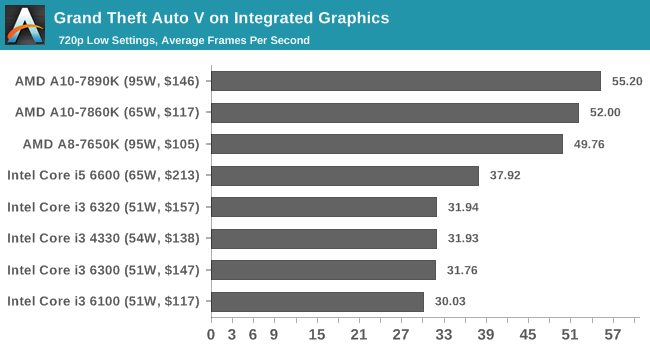
![Grand Theft Auto V on Integrated Graphics [Under 60 FPS]](https://images.anandtech.com/graphs/graph10543/83071.png)
The APUs take a large, almost double FPS lead for average frame rates, and again the Core i3 staircase shows that the L3 cache makes a difference. On the Low FPS graph, we see that none of the Intel CPUs make it above 60 FPS at any point, whereas the APUs can expect to see 15-30% of their time at or above 60 FPS.
Discrete Graphics
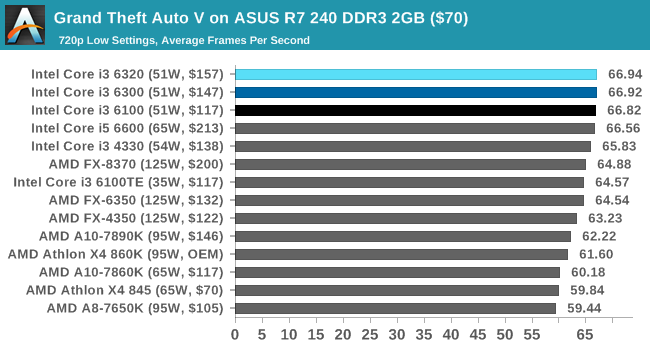
![Grand Theft Auto V on ASUS R7 240 DDR3 2GB ($70) [Under 60 FPS]](https://images.anandtech.com/graphs/graph10543/83079.png)
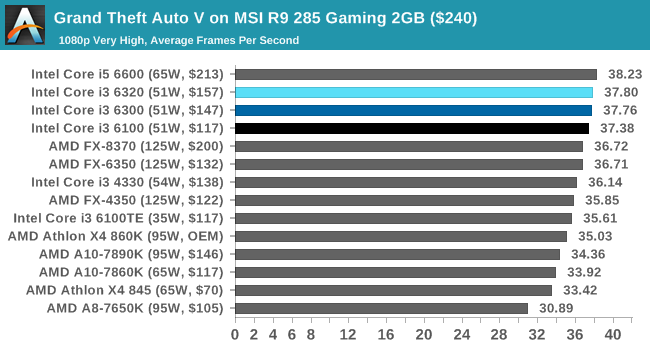
![Grand Theft Auto V on MSI R9 285 Gaming 2GB ($240) [Under 60 FPS]](https://images.anandtech.com/graphs/graph10543/83087.png)
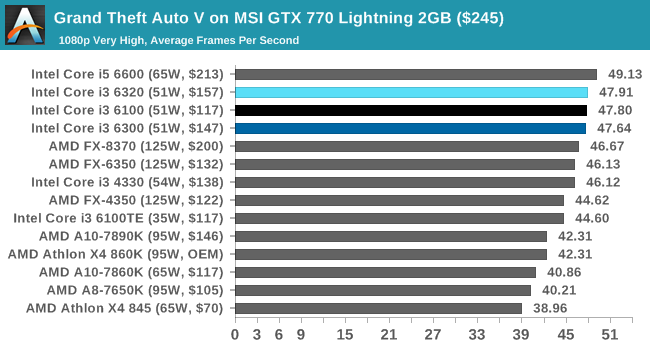
![Grand Theft Auto V on MSI GTX 770 Lightning 2GB ($245) [Under 60 FPS]](https://images.anandtech.com/graphs/graph10543/83095.png)
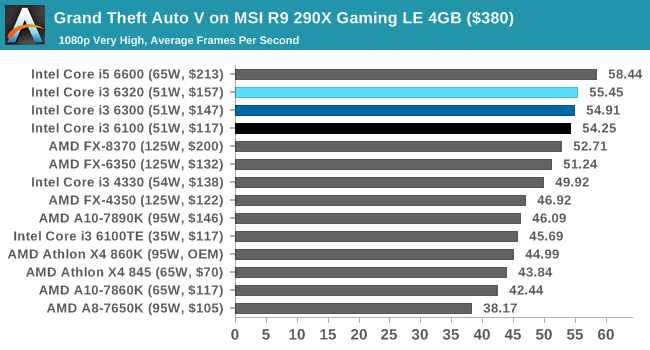
![Grand Theft Auto V on MSI R9 290X Gaming LE 4GB ($380) [Under 60 FPS]](https://images.anandtech.com/graphs/graph10543/83103.png)
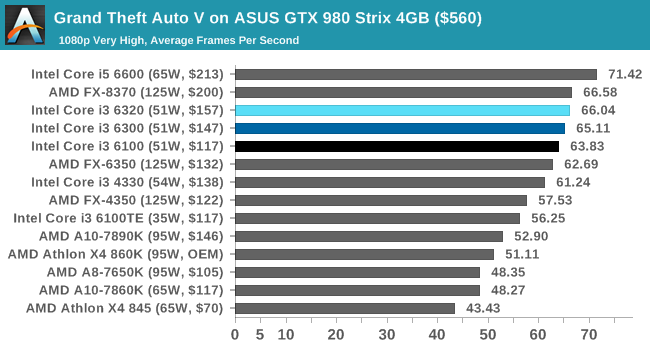
![Grand Theft Auto V on ASUS GTX 980 Strix 4GB ($560) [Under 60 FPS]](https://images.anandtech.com/graphs/graph10543/83113.png)
It's an onslaught of data, but clicking through to each graph will expand it in finer detail.
Again, with a discrete GPU, the Core i3s sit very pretty at the top of our graphs. In most cases, against similarly priced AMD CPUs, they can be from 5% to 20% quicker in average frame rates - the higher power the GPU, the more that it matters.
An interesting graph is the final one, with the GTX 980 and lookng at the percentage of frames over 16.6ms (i.e., the percentage time the game spends under 60 FPS). With the Core i3 parts, the game spends at least 50% of its time above 60 FPS running at 1080p Very High settings, however with similarly priced AMD APUs, this drops down to 15-25%. While running at V-Sync, this will be noticable. The FX CPUs get a better showing with the GTX 980, with the FX-6350 and the FX-8350 straddling the Core i3s for average frame rates and the 60 FPS metric.











94 Comments
View All Comments
Morawka - Monday, August 8, 2016 - link
It's still suprising to see it on a low end CPU. i didnt know the i3's had ECC, now i'm thinking of building a FREENAS box off of one of theseSamus - Tuesday, August 9, 2016 - link
You'd be surprised how many servers actually ship with i3's...those HP ML10's are incredibly common and I've seen a number of Lenovo SMB servers run i3's.The i3 is more than adequate for most small business servers unless they plan to run Hyper-V. Most other CPU intense services are cloud-based now (I personally think a business is crazy to maintain their own exchange server these days when Microsoft offers a $4/month/mailbox turn-key solution)
Basically all servers do now is run the domain and a few basic services like file sharing and routing. SQL, Exchange, even Hyper-V are all inexpensive Azure\Office365 services. It really comes down to who costs more, your IT guy, or Microsoft. Odds are, the IT guy. Unfortunate because I am one.
jardows2 - Monday, August 8, 2016 - link
Low end consumer CPU's. Intel likes the product segmentation between Xeon's and i5/i7. This is also why Intel forced the use of the "c" series chipsets for the Xeon processors. a Xeon E3-1240 v5 is about $30.00 cheaper than an i7 6700, with a higher base frequency, but slightly lower turbo frequency.Of course, this helps people who are wanting server grade, but only need low end processing power. A Pentium or an i3 would be a great home server chip, but i5 or i7 overkill. If you are wanting to use a higher-end production computer with ECC, you probably are looking at higher-end processors than i5 or i7 anyway.
However, AMD includes the support in all their AM3+ processors, and I believe in all their FM2 processors as well. Not every motherboard supports it.
sheh - Monday, August 8, 2016 - link
Yes, I was referring to non-server CPUs.But why is it on the i3? Not that I mind, but the surprising aspect and the problem is that it's not on i5 and i7.
Black Obsidian - Monday, August 8, 2016 - link
jardows2 covers that in his/her product segmentation reference.If you want ECC on the low end, Intel is happy to sell you an i3. If your needs are any higher, Intel wants to push you towards a Xeon (and C-series chipset), which IIRC are higher-margin parts than the i5 and i7, and happen to have gone through additional server-related validation.
satai - Monday, August 8, 2016 - link
I understand this concept but I still don't get why there are cheap ECC enabled i3s instead of more expensive (but still cheaper than 4C Xeons) dual-core Xeons...extide - Monday, August 8, 2016 - link
Yeah, that is kinda weird, you would think Intel would do that, and create even more segmentation, which is something they definitely tend to like to do.rhysiam - Monday, August 8, 2016 - link
My guess would be (and full disclosure... this an educated guess): at some point the market becomes too niche and the higher profit margins get lost to the additional costs of segmenting product lines, keeping different lines in stock, etc. The cheapest Xeon quad core on Newegg is already only $90 more than the cheapest i3. How much more could Intel actually charge for a dual core Xeon over the i3, the only benefit of which is ECC? Then they'd have to maintain a whole new product line, manage stock levels, etc. My guess is that for the relatively small number of customers pairing a dual core with ECC memory, it's just more trouble than it's worth.satai - Tuesday, August 9, 2016 - link
Thet sounds like a believable explanation.DanNeely - Monday, August 8, 2016 - link
What exactly is the point of the Core i3-6098P supposed to be? Compared to the equally priced I3-6100, it's slower, has a weaker GPU, and a higher TDP. On paper I can't see any reason to buy the former instead of the latter?